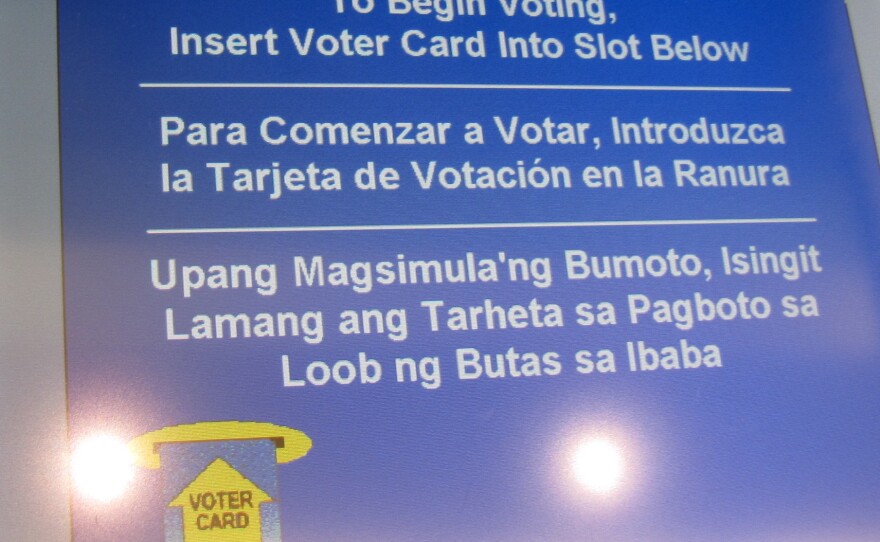On a recent weekend, a steady stream of shoppers made their way through Seafood City, Las Vegas’ biggest Filipino grocery. Cashiers greeted customers in the most common Filipino dialect, Tagalog, and rang up bitter melon, shellfish and tropical fruit.
This site also served as a polling place. Early voting has begun for the June 12 primary, and this time, there was something new on the ballot.
“Before we only had the English and the Spanish, now we have the Tagalog as a third language,” said poll worker Dalanm Villanueva, while pointing to the voting machine’s touch screen.
Villanueva is one of about 100 bilingual Tagalog-speaking poll workers and alternates that Clark County recruited this election. He is stationed at the polling place along with Spanish-speaking poll workers in case a voter needs help in either language.
Voter Ronnie Luneza, a 40-year old Filipino-American, was happy to see the Tagalog choice on the voting machine, even though he is a native English speaker.
“It is nice to be recognized now that Filipinos are a large part of the Las Vegas community, and it is just great to see that we are making accommodations for the Filipino voters,” Luneza said.
Luneza lived in Clark County long enough to see the Filipino population double to more than 86,000 in the last decade. Filipinos are the second-largest ethnic minority after Latinos.
Once a minority group reaches the magic number of 10,000 citizens who are not proficient in English -- or those limited-English speakers become five percent of the citizen voting age population -- that triggers a requirement under Section 203 of the Voting Rights Act.
Determinations are made every ten years following the census. Data released last October revealed that Filipinos in the U.S. reached that threshold in four new jurisdictions, including Clark County.
Many jurisdictions in the Southwest already offer Spanish ballots. In Arizona and New Mexico, ballots in Native American languages are also widespread.
Clark County was one of several western, urban jurisdictions that added a new Asian language translation this year. San Diego County added Chinese, and already offers Spanish, Vietnamese and Tagalog. Los Angeles County added Cambodian and Asian Indian to the six other languages the county previously offered.
Yet at Seafood City, the voting machine’s English option is popular, even among first-time Filipino voters like Danilo Navarette.
“You know what, I am practicing my English,” said Danilo Navarrete, while laughing. “I choose the English.”
In fact, English is commonly used in the Philippines, since there are more than 70 dialects spoken there. Clark County Registrar Larry Lomax had to quickly learn all that when he first learned about the translation mandate last October.
“Our first challenge was to select or determine what dialect predominates in Clark County,” Lomax said. “We put together a group of about 20 individuals and they had quite a heated discussion themselves.”
The version they settled on is technically known as Filipino, (or Pilipino), the national language of the Philippines, though locally it is commonly referenced as Tagalog.
Lomax had to get special permission to break the county’s hiring freeze in order to bring on a staff person who could speak the language and do the translations. Earlier this year, his office sent out mailings to a targeted list of voters, with the option to receive correspondence in either Tagalog or Spanish.
Spanish was a popular choice. Tagalog, not so much.
Still translation really does boost turnout, said Las Vegas attorney and voting rights expert, Jim Tucker.
“You actually have the data before and after,” Tucker said. “When the jurisdiction becomes covered, you will see the participation skyrocket if the jurisdiction is doing what it is supposed to do.”
Translations and bilingual poll workers can make the difference whether someone votes or not, especially when it comes to tricky ballot propositions.
“We've had some people that have just told us flat out, ‘I just stopped voting because I couldn't understand everything and I was embarrassed, I didn't want to cast a ballot on something I didn't understand,’” Tucker said.
For any immigrant to vote, they first have to be naturalized U.S. citizens. Filipinos in Southern Nevada, it turns out, are doing that at a very high rate. Even though their numbers are smaller than the local Mexican population, Filipino naturalizations outnumbered Mexicans two years ago -- making them the largest group of new citizens in Nevada in 2010.
Back at the polling place at Seafood City, voter Danilo Navarette is hopeful of what this could all mean.
“We are still a minority population here in America, but maybe in five years or 10 years more…” Navarrate said.
Maybe then a more sizable Filipino voting bloc in Las Vegas and elsewhere could really make a political impact.






